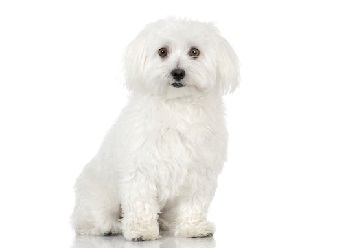 Fluffy and cute, the Maltese has always been an affectionate breed. It is commonly known as the Maltese Terrier although this is not the correct name for the breed.
Fluffy and cute, the Maltese has always been an affectionate breed. It is commonly known as the Maltese Terrier although this is not the correct name for the breed.
No one is 100% sure of the origin of this breed; however, there are claims the breed originated on the island of Malta. There are even records of the breed dating back to 6000BC. They are thought to have been worshiped by the ancient Egyptians and are today known as a popular lapdog.
Personality
The personality of a Maltese is a gentle and affectionate one. They do very well in obedience training and even make quite good watchdogs as they are loyal and protective of their owners. It is their intelligence that helps them excel as show dogs and in obedience.
As puppies, their energy levels are quite high, but as they grow older they reduce. Because they are smart dogs, they need you to set boundaries from the beginning. It is important to train and socialize your pup in the early days, as these basic rules will come in handy as the dog gets set in their ways as an adult.
Upkeep
The glamorous Maltese are a high-maintenance breed if kept in long coats, such as with show dogs. As pets, clipping the hair short is recommended for less time-consuming and easier grooming. A daily brush will be needed to keep their fur in good condition and to get rid of knots and matting. A fortnightly bath will help to keep their fur shiny and knot-free.
Maltese are indoor dogs and should not be left out to get wet as they don’t have an undercoat and will get sick.
Maltese, along with other white-colored breeds, are prone to tear stains around the eyes. Keeping the hair away from the eyes will help to prevent this. Also, some individual Maltese dogs stain more than others, especially as puppies during teething.
Maltese are certainly not the type that longs for hiking in the bush and prefer the comforts of being at home. They are couch potatoes at heart, but do enjoy a play in a secure garden. To satisfy their exercise needs, a short 30-minute walk is sufficient as well as plenty of play at home while they are young pups.
Because the highly active Maltese are predisposed to knee joint problems (luxating patella), regular exercise is important to keep their knee joints nice and firm. However, avoid your puppy from over-exercising and jumping off high places to prevent injury and increase the risk of the condition.
Like all dogs, your Maltese will need regular flea, tick and worming treatment. You can ask your local veterinarian for advice. De-sexing and vaccination against diseases, such as the deadly parvo virus and highly contagious canine cough, are also important to talk with about your vet.
Compatibility
Because they don’t have an undercoat, Maltese are excellent for people with allergies. Preferring the comforts of home, they can be quite well-suited to the elderly or a doting owner willing to spend plenty of time grooming and pampering their dog.
They are not suitable for families with children under the age of five as Maltese puppies are fragile and can get injured if dropped or squeezed by little, inexperienced hands.
Maltese can be quite happy living in an apartment as long as they get walked daily and get plenty of cuddles and attention from their owner.
Fact file
Breed classification Toy
Size Small
Origin Malta
Lifespan 11+ years
Colors Pure white, but slight lemon markings
Cost $1200-$1500
Common hereditary problems Luxating patella and liver shunt.
